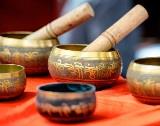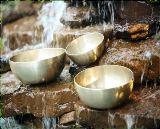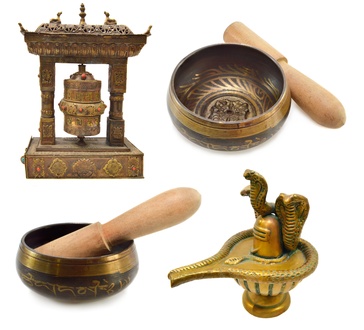 Have you heard of the healing effect of “singing bowls”? The “rin” gongs (Tibetan Singing Bowls) or the “suzu” gongs also known as the Himalayan bowls have seemingly supernatural healing powers that shamans and other spiritual healers claim. The singing bowls do not hang like most gongs but rather sits on its bottom surface like a bowl, thus the name – Singing Bowls. The ancients believe that the unique first and third harmonic frequencies of the singing bowls have healing effects on the human body.
Have you heard of the healing effect of “singing bowls”? The “rin” gongs (Tibetan Singing Bowls) or the “suzu” gongs also known as the Himalayan bowls have seemingly supernatural healing powers that shamans and other spiritual healers claim. The singing bowls do not hang like most gongs but rather sits on its bottom surface like a bowl, thus the name – Singing Bowls. The ancients believe that the unique first and third harmonic frequencies of the singing bowls have healing effects on the human body.
Ancient Origins of the Singing Bowls
All over the world singing bowls are being used for personal well-being, music, meditation and relaxation. Historically singing bowls first appeared in Asia and the oldest known artifacts were from Japan, China and Nepal. They are one of the most common traded items in the Silk Road in ancient times and are still ever in demand to this day. Korea, India, Nepal, China and Japan are the leading manufacturers of the singing bowls today.
History
Singing bowls are often used for religious purposes and it is usually associated with the beginnings or endings of certain meditation in the Buddhist traditions in Tibet; while in Japan and Vietnam it signifies the change in chant or stance and in other places in Asia it is used in traditional funeral rites and ancestor worship.
Buddhist traditions in Tibet; while in Japan and Vietnam it signifies the change in chant or stance and in other places in Asia it is used in traditional funeral rites and ancestor worship.
It is unfortunate that although these singing bowls are significant religious relics in Central Asia, yet there are no known written records of them. Even more frustrating is that they are rarely mentioned in the oral traditions of the Tibetan clans from which they supposedly originated from. However, we do know that bronze bells are already present in Asia around 800 – 1,000 BC and recent carbon dating of singing bowls found in an ancient Buddhist temple in Tibet suggests that the Tibetan rinpoches and monks were using bronze singing bowls as far back as 1,000 AD.
Other uses of singing bowls include sound healing, performance, yoga, religious services, music therapy and for personal enjoyment.
How to Play the Tibetan Singing Bowls
 When playing the Tibetan Singing Bowl, you’ll need a padded mallet to strike the rim of the bowl. This makes a soft bursting sound that has a tempo and can be controlled according to your musical style. Another way to play it is by rubbing a wood, plastic, or leather wrapped mallet around the rim of the bowl. The friction will create harmonic overtones and if you continuously rub and apply friction on it, it will create something like a “singing sound,” and thus the name – Singing Bowls.
When playing the Tibetan Singing Bowl, you’ll need a padded mallet to strike the rim of the bowl. This makes a soft bursting sound that has a tempo and can be controlled according to your musical style. Another way to play it is by rubbing a wood, plastic, or leather wrapped mallet around the rim of the bowl. The friction will create harmonic overtones and if you continuously rub and apply friction on it, it will create something like a “singing sound,” and thus the name – Singing Bowls.
How the Singing Bowls Heal People
Until recently, medical doctors have finally concluded based on lab results and research that music indeed has healing properties. Modern meditation techniques suggests yoga enthusiasts and other practitioners to incorporate lighting effects, sweet incense, oils, flowers and perfumes as well as soothing music to set up the mood before meditating. The MRI (magnetic resonance imaging) results before and after a person meditates with music and other mood-setters in his or her meditation room show improved brain activity and increased dopamine levels in the brain as well. Dopamine, as you know well, is a naturally-occurring chemical in the brain that helps the body relax and experience pleasure. It heals your mind and body for short.
The rhythm and harmonic overtones of the Singing Bowls vibrates at just the right frequency that the human brain responses to and release dopamine. Scientists are baffled as to how the ancient people were able to make this achievement when they do not have the knowledge that we have today. Or do they?
Johanna Oosterwijk N.D.


